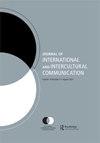Hong Kong's vehicles of democracy: The vernacular monumentality of buses during the Umbrella Revolution
IF 2.2
Q2 COMMUNICATION
Journal of International and Intercultural Communication
Pub Date : 2020-10-01
DOI:10.1080/17513057.2019.1646789
引用次数: 2
Abstract
ABSTRACT Hong Kong's Umbrella Revolution saw some of the city's busiest streets transformed into temporary sites of artistic expression and freedom. This essay explores the everyday items were turned into in-situ tools of protest – in particular, the subversive use of double-decker buses. I analyze how a number of double-decker buses were transformed from a form of moving rhetoric into static, vernacular monuments representing Hong Kong's history and serving as democratic billboards. Through the display of Hong Kong's present (mainlandization), past (colonization), and future (democracy), the city's protesters were, I suggest, able to communicate their fears about the increasing effects of mainlandization in an attempt to shift Hong Kong's political possibilities.香港的民主交通工具:雨伞革命期间巴士的本地纪念性
香港的雨伞革命让这座城市最繁忙的街道变成了艺术表达和自由的临时场所。这篇文章探讨了日常物品被转化为现场抗议的工具,特别是双层巴士的颠覆性使用。我分析了一些双层巴士是如何从一种移动的修辞形式转变为代表香港历史的静态、乡土的纪念碑,并充当民主广告牌的。我认为,通过展示香港的现在(大陆化)、过去(殖民化)和未来(民主),这个城市的抗议者能够传达他们对大陆化日益严重的影响的担忧,试图改变香港的政治可能性。
本文章由计算机程序翻译,如有差异,请以英文原文为准。
求助全文
约1分钟内获得全文
求助全文
来源期刊

Journal of International and Intercultural Communication
COMMUNICATION-
CiteScore
3.80
自引率
12.50%
发文量
19
 求助内容:
求助内容: 应助结果提醒方式:
应助结果提醒方式:


